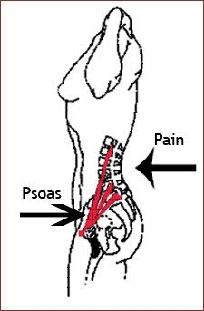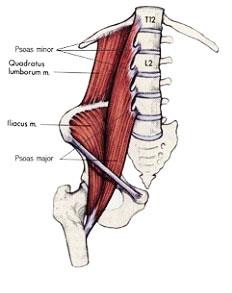Excerpts from Liz Koch and Barry Krost
Links: www.CoreAwareness.com
www.squidoo.com/psoas
Key to skeletal balance, a sense of orientation and muscular coordination, the balanced pelvis forms a rim-like base for the spinal vertebrae, rib cage, shoulder girdle and head. Shortening of the psoas leads to a host of unfortunate conditions. Inevitably, other muscle groups become involved in compensating for the loss of structural integrity and pelvic instability. Pelvic instability shows itself as pelvic tilts, forward flexion, twists, dips or torques. Symptoms associated with instability include mid and low back pain, hip socket tension, leg length discrepancies, knee and ankle problems, TMJ and jaw pain, difficulty in breathing, groin pain, shoulder pain, difficulty in standing and walking, and excessive muscle tension throughout the body. Even headaches and dizziness may be traced to pelvic instability.
A supple dynamic psoas plays a vital role in integrating physical and emotional health. Fear plays havoc on the pelvic keystone. A chronically constricted psoas (locked in preparation for the flight/fight or freeze response) restricts movement and pulls on the pelvic bones compromising not only pelvic integrity but organ and sexual functioning. In addition, any tension within the pelvis will be reflected in the jaw and visa versa. Grinding teeth is the body’s proprioceptive method for regaining balance, coordination and positioning while maintaining the essential flow of synovial fluid throughout the central nervous system. Dental surgery, orthodontic apparatuses and accidents affecting the face, jaw and head will also alter the coherent relationship between cranium and sacrum.
A vital key to prevention and self-corrective possibilities rests with one muscle, the psoas (so-az.) Getting to know this muscle can have far reaching results in reducing wear and tear on the hip joints, knees and spine. A supple, dynamic psoas reduces stress, enhances digestion and eliminates fatigue. Here are a few facts about the psoas that might encourage you to develop a better relationship with yours.The psoas is the core muscle of the body, maintaining fluid motion while walking. It attaches along the front of the spine. It is the only muscle attaching the spine to the leg, as it spans from solar plexus to upper thigh. All problems associated with the lower back, hip joints, knees and ankles can be greatly improved by releasing tension in the psoas and engaging it properly while sitting and walking. However, the psoas is more than a muscle. It is also a shelf, providing support for all the abdominal organs. In addition, it is a hydraulic pump that, in combination with the diaphragm, massages the internal organs, viscera and spinal fluid. It is also part of the fear reflex (the fight or flight response,) and has a great deal to do with your emotions. Gaining a supple psoas relieves a wide range of symptoms; everything from menstrual cramps, water retention, sleep difficulties and foot rotations to recovering from deep-seated fears and trauma. Like some info-mercial products, learning about your psoas muscle is likely to help just about everything.
A simple technique for releasing your psoas is the Constructive Rest position:

A.(On the floor) Constructive Rest Position: Rest on your back with knees bent and your feet placed parallel to each other, the same distance apart as the front of your hip sockets. Place your heels approximately 16-24 inches away from your buttocks. Keep your trunk and head parallel with the floor. DO NOT push or flatten the spine or tuck your pelvis. Spend approximately 20 minutes a day simply being in Constructive Rest. Gravity releases the iliopsoas muscle, frees the diaphragm and slows the parasympathetic nervous system. This position provides a restful, yet dynamic opportunity to observe the inner fluid of the core. With no agenda and no destination, experience what is. As you rest in this position, tune your attention to sensation. What are you sensing? What are you feeling? What is the sensation of your emotions? Notice your thoughts, images and daydreams. Return to sensation. Each time begin with the sense of weight and connection to the ground. You may find that you begin to shake as your core melts, like ice crumbling. Allow soft but open eyes and when ready roll to your side.

B. (Side position) Fluid Fish Movement: Resting on your side, begin with rocking gently. Imagine your spine like a fish – fluid and wavelike – move towards a soft lateral and up/down giggling. Allow the freedom of random movement to take over your exploration. Melting and softening, the movement you have evoked will begin to guide. Let go and let yourself be moved.

C. Using leg support in the Constructive Rest position

D. Another Constructive Rest position

E. Supporting client releasing their own psoas muscle while in the Constructive Rest position
To keep your hip sockets open and your pelvis balanced while sitting, here is another exercise: Use a flat seated chair and sit with your pelvis level and your weight in front of your tuberosities (sits bones.) Keep your hips parallel with the floor and the knees lower than your hip sockets. This keeps the psoas released while it increases blood circulation throughout the hip sockets, legs and feet.
Getting to know your psoas and learning ways to free its movement will keep your inherent self-corrective system vital. This leads to ease of movement and self-expression. Tuning into your psoas can help you face life with a smile.
Liz Koch is the author of The Psoas Book, a comprehensive guide to the Iliopsoas Muscle and its profound effect on the body/mind/emotions.
The biggest factor in back and hip pain is the psoas muscle. The number of problems caused by the psoas is quite astonishing. These include: low back pain, sacroiliac pain, sciatica, disc problems, scoliosis, hip degeneration, knee pain, menstruation pain, infertility, and digestive problems, neck pain and disc problems, . The list can also include biomechanical problems like pelvic tilt, leg length discrepancies, kyphosis, and lumbar lordosis.
What is the psoas?
The psoas (pronounced “so – az”) is a bilateral muscle that primarily flexes the hip and the spinal column. At about 16 inches long on the average, it is one of the largest and thickest muscles of the body (in animals it’s known as the tenderloin). This powerful muscle runs down the lower mid spine beginning at the 12th thoracic vertebrae connecting to all the vertebral bodies, discs and transverse processes of all the lumbar vertebrae down across the pelvis to attach on the inside of the top of the leg at the lesser trochanter. The lower portion combines with fibers from the iliacus muscle, which sits inside the surface of the pelvis and sacrum, to become the Iliopsoas muscle as it curves over the pubic bone and inserts on the lesser trochanter.

What is the function of the psoas?
The psoas has a number of diverse functions making it a key factor in health. The psoas as a hip and thigh flexor is the major walking muscle. If the legs are stationary the action of it is a bend the spine forward; if sitting it stabilizes and balances the trunk. The lower psoas brings the lumbar vertebrae forward and downward to create pelvic tilt.
When we think of smooth, elegant and graceful movement in dancers and athletes we are looking at the psoas functioning at it optimum. It requires that the psoas maintain the pelvis in a dynamically neutral orientation that can move easily and retain structural integrity. This creates positions of the spine that require the least muscular effort.
The psoas muscle is a guy wire for the spine. It is also a hydraulic pumping system stimulating all circulatory systems, a psoatic shelf supporting organs and viscera and it is part of the fear reflex system preparing one to flee or fight. Sitting for long periods of time with a constricted psoas muscle depletes vital energy, curtails blood circulation, affects organ functioning and signals flee/fight reflex thus draining the adrenals and immune system. It’s health and suppleness affects every level of well being.
What are the common pain symptoms of the psoas?
When the muscle becomes contracted due to injuries, poor posture, prolonged sitting, or stress, it can alter the biomechanics of the pelvis and the lumbar, thoracic and even cervical vertebrae. Typically a dysfunctional psoas is responsible for referred pain in the back and often down the sciatic nerve. Trigger points are generally found on the abdomen. Frequently the quadratus lumborum muscles develop trigger points, as well as the piriformis, gluteals, hamstrings, and erector spinae.

Frequently one psoas will shorten and pull the spine and/or pelvis to our dominant side. The distortions of the spine and pelvis can also show up as a short or long leg. This all results in a roto-scoliosis advancing all the way up to the neck (even causing TMJ syndrome), lordosis (sway back – causes back pain & ‘prominent’ belly i.e abdominal contents spill forward making you look heavier), trigger points, and spasms in back muscles trying to resist the pulling of the psoas.
It can pull the spine downward, compressing the facet joints and the intervertebral discs of the lumbar spine. The pressure can cause the discs to degenerate, becoming thinner and less flexible. This degeneration makes the discs more susceptible to bulging or tearing, especially with twisting and bending movements.
Other repercussions are: limited pelvic volume, constricted organs, impinged nerves and impaired diaphragmatic breathing. Putting pressure on the uterus, a tense or short psoas can cause painful menstrual cramping. Pushing the esophagus forward, a tight upper psoas can cause digestive problems. A short psoas pulls the diaphragm down and forward, limiting breathing.
Your psoas influences your:
- Skeletal balance
- Flexibility
- Range of motion
- Joint rotation
- Organ functioning
- Breathing
- Circulation
- Adrenal/Immune health
- Nerve functioning
- Emotional stability
- Giving Birth Naturally
- And More!
What keeps the psoas in contraction?
The psoas will stay contracted because of postural habits and trauma. The way we stand, walk and sit can distort the psoas. We often sit with our head forward (computer work, studying, driving) which shortens and tightens the psoas. Over time we develop a habitual way of holding the psoas that is dysfunctional.
Unresolved trauma can keep the psoas short and reactive. This is a primary muscle in flight, fight, freeze or fear responses to danger – or in today’s world, persistent stress and anxiety. Until the psoas is released the muscle may stay contracted and go into further shortening and spasm very easily.
A constricted upper psoas instead of freeing the rib cage and elongating the spine collapses the chest and hyper-extends the lumbar spine. Using a back pillow for the small of the back or the neck to relieve back pain (a result of a hyper-extended spine) is only another band aid approach to a much deeper problem, a constricted psoas.
Core Awareness begins with the sits bones. The jaw and pelvis communicate with each other. Positioning of the pelvis influences the jaw/head/eyes. Sitting on and slightly in front of the sits bones, movement is initiated from a supple dynamic core and moves out through the fingers (Compared with a static core that fixates the eyes and isolates the wrists and hands).